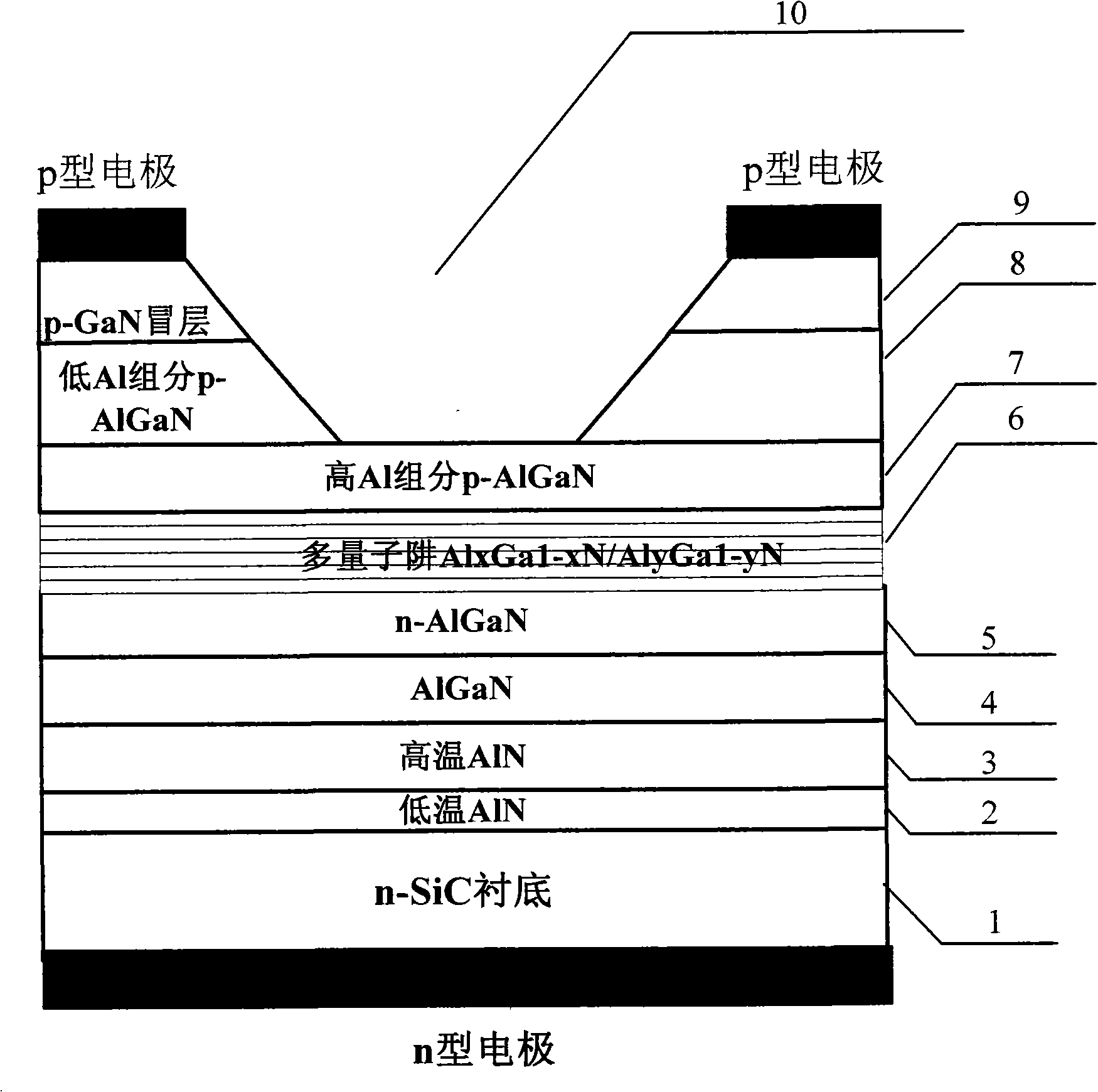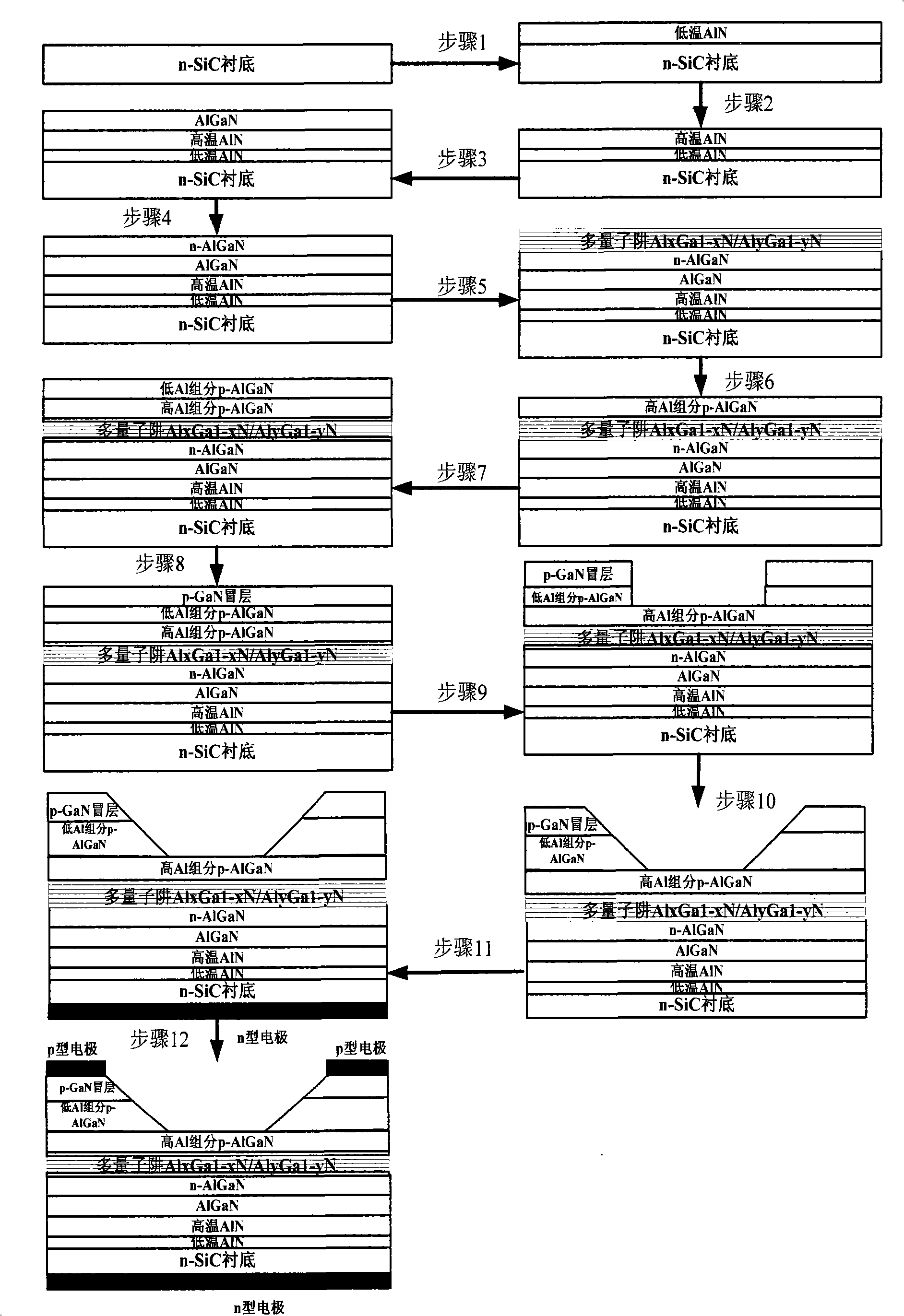AlGaN-based multiple quantum well uv-LED device based on SiC substrate and manufacturing method
A quantum well and device technology, applied in semiconductor devices, electrical components, circuits, etc., can solve the problems of high turn-on voltage, long exit path, and only 0.01% external quantum efficiency, so as to increase output power, increase exit power, The effect of promoting the practical process
- Summary
- Abstract
- Description
- Claims
- Application Information
AI Technical Summary
Problems solved by technology
Method used
Image
Examples
Embodiment 1
[0049] Embodiment 1. On the SiC substrate, a light exit window similar to a cone is fabricated by ICP dry and wet etching, and the steps are as follows:
[0050] Step 1: On the SiC substrate 1, a low-temperature AlN nucleation layer 2 is grown by MOCVD process.
[0051] The substrate temperature was lowered to 600°C, the growth pressure was maintained at 50Torr, the flow rate of hydrogen gas was 1500 sccm, the flow rate of ammonia gas was 1500 sccm, and the aluminum source with a flow rate of 28 μmol / min was introduced into the reaction chamber to grow a low-temperature AlN nucleation layer with a thickness of 10 nm.
[0052] Step 2, growing a high-temperature AlN nucleation layer 3 on the low-temperature AlN nucleation layer 2 .
[0053] Raise the growth temperature to 1050°C, keep the growth pressure at 50 Torr, the flow rate of hydrogen gas at 1500 sccm, the flow rate of ammonia gas at 1500 sccm, feed the aluminum source at a flow rate of 28 μmol / min into the reaction chamb...
Embodiment 2
[0080] Embodiment 2, on the SiC substrate, use ICP dry method and wet etching method to make a light exit window similar to a cone, the steps are as follows:
[0081] Step 1: On the SiC substrate 1, a low-temperature AlN nucleation layer 2 is grown by MOCVD process.
[0082] The substrate temperature was lowered to 600°C, the growth pressure was maintained at 50Torr, the flow rate of hydrogen gas was 1500 sccm, the flow rate of ammonia gas was 1500 sccm, and the aluminum source with a flow rate of 28 μmol / min was introduced into the reaction chamber to grow a low-temperature AlN nucleation layer with a thickness of 10 nm.
[0083] Step 2, growing a high-temperature AlN nucleation layer 3 on the low-temperature AlN nucleation layer 2 .
[0084] Raise the growth temperature to 1050°C, keep the growth pressure at 50 Torr, the flow rate of hydrogen gas at 1500 sccm, the flow rate of ammonia gas at 1500 sccm, feed the aluminum source at a flow rate of 28 μmol / min into the reaction ...
Embodiment 3
[0111] Embodiment 3, on the SiC substrate, a light exit window similar to a cone is fabricated by ICP dry and wet etching, and the steps are as follows:
[0112] Step 1: On the SiC substrate 1, a low-temperature AlN nucleation layer 2 is grown by MOCVD process.
[0113] The substrate temperature was lowered to 600°C, the growth pressure was maintained at 50Torr, the flow rate of hydrogen gas was 1500 sccm, the flow rate of ammonia gas was 1500 sccm, and the aluminum source with a flow rate of 28 μmol / min was introduced into the reaction chamber to grow a low-temperature AlN nucleation layer with a thickness of 10 nm.
[0114] Step 2, growing a high-temperature AlN nucleation layer 3 on the low-temperature AlN nucleation layer 2 .
[0115] Raise the growth temperature to 1050°C, keep the growth pressure at 50 Torr, the flow rate of hydrogen gas at 1500 sccm, the flow rate of ammonia gas at 1500 sccm, feed the aluminum source at a flow rate of 28 μmol / min into the reaction chamb...
PUM
 Login to View More
Login to View More Abstract
Description
Claims
Application Information
 Login to View More
Login to View More - R&D
- Intellectual Property
- Life Sciences
- Materials
- Tech Scout
- Unparalleled Data Quality
- Higher Quality Content
- 60% Fewer Hallucinations
Browse by: Latest US Patents, China's latest patents, Technical Efficacy Thesaurus, Application Domain, Technology Topic, Popular Technical Reports.
© 2025 PatSnap. All rights reserved.Legal|Privacy policy|Modern Slavery Act Transparency Statement|Sitemap|About US| Contact US: help@patsnap.com


